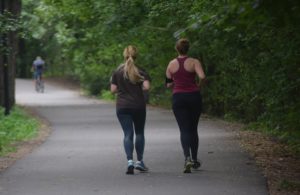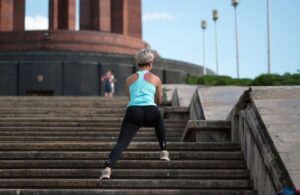Leading a sedentary lifestyle, often colloquially described as being a couch potato, can have detrimental consequences on one's health, including an increased risk of developing chronic conditions such as obesity, type 2 diabetes, and cardiovascular disease. It also exacerbates feelings of lethargy and can impact mental health.
Transitioning to a more active lifestyle can be initiated by incorporating moderate activities into your daily routine, such as taking the stairs instead of the elevator, engaging in short, frequent walking breaks, or participating in recreational sports. Starting with small, achievable goals can help build the momentum needed for long-term behavioural change.
Building a support network by involving friends or family can also provide encouragement and accountability, fostering a more sustainable shift to an active way of living.
The first steps to an active life
Walking is often undervalued in its capacity as a form of exercise, yet it is one of the most accessible and effective ways to maintain physical health and enhance mental wellbeing.
Beginning with a basic walking regimen allows individuals of any fitness level to start their journey towards a healthier lifestyle. Advancing from a gentle stroll to brisk walking or power walking increases the cardiovascular benefits, leading to improved endurance and weight management.
Consistency in walking routines is crucial; it ensures that the body adapts positively over time, making strides not just in physical health but also in cultivating a habit that supports overall wellness and stress reduction.
Jogging is an exhilarating way to improve your cardiovascular fitness, but it’s important to approach it with care to avoid injury. Start by investing in a pair of proper running shoes that offer good support and fit your feet well to ensure comfort and reduce the risk of blisters and joint pain.
Once you've got the right footwear, begin by alternating between walking and jogging, gradually increasing the time spent jogging as you feel more comfortable.
Remember to listen to your body and to pace yourself—starting slow and steady is the key to building endurance without putting undue stress on your body.
Unlocking the joys of cycling
Cycling need not be an overwhelming endeavour; it's quite the contrary. After initially acquainting oneself with leisurely rides, the next step could be to routinely incorporate cycling into one's daily routine, such as cycling to work or performing errands. This not only fosters a sustainable lifestyle but also ensures consistent, low-impact exercise.
Moreover, weekend cyclists might consider joining local cycling clubs or groups, which often cater to various skill levels and provide a social dimension to the activity, enhancing motivation and enjoyment.
Cyclists often encounter plateaus, where progress seems to stall despite regular training. To overcome this, introducing variety into cycling routines can reignite progression.
Incorporating interval training, with alternating bursts of intense effort and recovery periods, can dramatically improve aerobic capacity. Moreover, exploring different terrains, such as hill climbs or off-road trails, challenges different muscle groups and enhances bike handling skills.
For those using cycling as a regular means of transport, opting for longer or more varied routes can not only contribute to fitness gains but also instil a greater appreciation for the journey itself, turning a functional activity into an adventurous exploration.
Joining group classes
Yoga, an ancient practice rooted in over 5,000 years of Indian philosophy, extends beyond physical exercises; it fosters a holistic approach to health and well-being. Incorporating it into one's lifestyle can lead to significant improvements in flexibility and mobility, as it gently stretches and strengthens the muscles.
Moreover, the mindful element of yoga can help alleviate stress, enhance concentration, and promote a serene mind. For beginners, it is advisable to commence their journey with a basic Yoga class, often recommended for its slower pace and focus on breathing and alignment. This foundation paves the way for a sustainable and safe yoga practice, encouraging gradual progression both physically and mentally.
At the heart of Pilates lies a deep focus on the core, the 'powerhouse' of the body. By emphasising precision and control, Pilates exercises are designed to activate the stabilising muscles of the abdomen and lower back, enhancing postural alignment and stability.
Regular practice not only leads to a sculpted physique but also equips the body with the strength necessary to perform daily activities with greater ease, reducing the risk of injuries. Through controlled breathing and mindful movements, practitioners can expect to see improvements in concentration, coordination, and overall body awareness.
Personal training
Personal trainers do much more than simply supervise workouts; they're instrumental in crafting tailored fitness programmes that take into account the unique body mechanics, goals, and health conditions of each client.
This personalised approach ensures that exercise routines are efficient and effective, thereby maximising the potential for progress. Furthermore, trainers provide invaluable accountability, a key ingredient for consistent application and sustained motivation, which are essential for achieving long-term fitness objectives.
People always ask, is a personal trainer worth it? The answer for most people is a definite yes.
Nutrition is arguably as important as exercise when it comes to maintaining a healthy lifestyle. A balanced diet consists of the right proportions of macronutrients, proteins, carbohydrates, and fats as well as essential vitamins and minerals. This balance is crucial not only for energy but for recovery, immune function, and the overall functioning of the body.
Personal trainers, while not dietitians, can offer basic nutritional guidance to support their clients' fitness goals, such as emphasising whole foods over processed foods, proper hydration, and the timing of meals in relation to workouts.
It is important, however, for trainers to recognise the boundary of their expertise and when to refer clients to licensed nutrition professionals for in-depth dietary advice.
Implementing Breathwork into your exercise routine
Breathwork can be a powerful addition to your exercise routine, acting as a catalyst for improved performance and recovery. To begin incorporating breathwork, start with the simple technique of diaphragmatic breathing.
Find a comfortable seated or lying position and place one hand on your stomach. As you inhale deeply, focus on expanding the diaphragm rather than the chest. Exhale slowly and repeat this process for several minutes, gradually increasing the duration as you become more accustomed to the technique.
To maintain consistency, schedule regular breathwork sessions into your weekly routine, just as you would with physical training sessions. Use a journal to note down your experiences and any improvements in your exercise performance or recovery times. This will help you to track your progress and stay motivated.
Remember, as with any new practice, patience and consistent effort are key to realising the full benefits of breathwork in your exercise routine.
An enhanced mood
Embracing physical activity is a transformative journey that begins with the first step of recognising the importance of physical health in one's lifestyle.
Over time, consistent participation in physical exercises can lead to increased stamina, improved mental clarity, and resilience against chronic illnesses. An active lifestyle has also been linked with enhanced mood and a general sense of well-being, attributable to the release of endorphins.
For many, the integration of regular activity becomes a cornerstone of a robust daily routine, paving the way for a healthier and more fulfilling life.


















